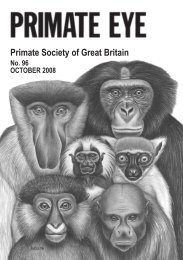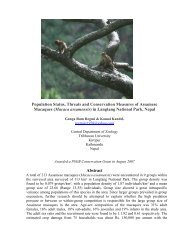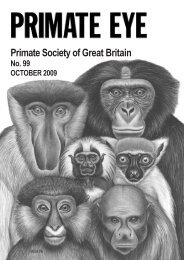2010 Vol 101.pdf (1.63mb) - Primate Society of Great Britain
2010 Vol 101.pdf (1.63mb) - Primate Society of Great Britain
2010 Vol 101.pdf (1.63mb) - Primate Society of Great Britain
Create successful ePaper yourself
Turn your PDF publications into a flip-book with our unique Google optimized e-Paper software.
EDITORIAL<br />
This time last year, I commented on the media hoopla surrounding the<br />
announcement <strong>of</strong> Ida, the now-world-famous ‘missing link’ (or<br />
cercamonine adapid strepsirhine, as I suggested). A scientific response<br />
subsequently appeared; Seiffert et al. (Nature 461: 1118-1121, 2009)<br />
reported the discovery <strong>of</strong> a new African adapid (Afradapis longicristatus)<br />
similar to Darwinius (Ida’s genus); the authors showed convincingly that<br />
both <strong>of</strong> these Eocene genera belong to the strepsirhine side <strong>of</strong> the primate<br />
clade. Not surprisingly, this did not make the front page <strong>of</strong> every daily<br />
newspaper, nor did it generate any television news coverage. Thus, once<br />
again, the non-Nature-reading general public are left with the mental<br />
residue <strong>of</strong> misleading hyperbole without exposure to the more considered,<br />
analysis-driven research.<br />
Sadly, it would appear that the cycle is beginning again. Anderson et al.<br />
(<strong>2010</strong>) sparked a similar media feeding-frenzy with their recent paper<br />
entitled ‘Pan thanatology’.* The authors suggest that the behaviour <strong>of</strong><br />
captive chimpanzees during the period surrounding the death <strong>of</strong> a member<br />
<strong>of</strong> the troop bears similarities to the reactions <strong>of</strong> humans to the death <strong>of</strong> a<br />
relative. The new coverage, on the other hand, went straight to the<br />
conclusion that chimpanzees have a human-like understanding <strong>of</strong> death;<br />
they illustrated the story with an older photo, taken from National<br />
Geographic, showing an unrelated group <strong>of</strong> chimpanzees. As with the Ida<br />
debacle, the journal article raises legitimate scientific issues; the academic<br />
debate has already begun on the Current Biology website<br />
. The public-at-large, however, will<br />
almost necessarily be excluded from these discussions. As a result,<br />
‘conclusions’ reached entirely by the print and online media (‘Chimps<br />
grieve when faced with death’, as reported in the Independent newspaper)<br />
will be accepted as legitimate inferences. And, as with other media<br />
favourites like aquatic ape ‘theory’, it means I’ll have to spend an inordinate<br />
amount <strong>of</strong> my lecturing time have to ‘un-teach’ this to my students.<br />
There may not be a simple solution to this frankly unacceptable state <strong>of</strong><br />
affairs. We are increasingly urged by our institutions and granting agencies<br />
to make our work accessible to the general public. This brings us into<br />
contact with reporters, who are under pressure to deliver content that can be<br />
considered news (derived from the word ‘new’, implying an emphasis on<br />
novelty) and that will generate interest at a glance. There is little room for<br />
caveats, modifiers or conditions – as Ben Goldacre’s Guardian column<br />
continually points out, the media filtering process <strong>of</strong>ten results in<br />
simplifying to the point <strong>of</strong> deception. One colleague <strong>of</strong> mine provided<br />
ample information on a recent journal article to the print media, only to<br />
have the country in which the research took place misreported and to have<br />
his name attached to entirely made-up quotes. Another had hours <strong>of</strong><br />
1






